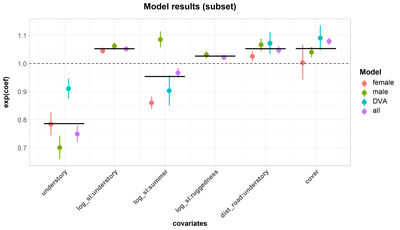Using step-selection functions to analyze European roe deer movement in relation to roads in the Bavarian Forest National Park
Katrin Kirchner
In Germany, roe deer (Capreolus capreolus) is with 84% the main trigger of Wildlife vehicle collisions. The effectiveness of current precautions is controversial. Therefore, a better under-standing of roe deer movement behavior in the vicinity of roads is crucial for future accident prevention. In the literature it is suggested, to inve stigate movement behavior, as it has more impact on ungulate vehicle collisions (UVCs) than e.g. traffic density. Therefore, the main drive of this thesis was to acquire more knowledge about movement selection preferences of roe deer in general and toward roads. I ntegrated step selection functions (iSSFs) were used to investigate step wise movement selection. Four models with the focus on general and gender specific pattern were made. In addition, movement behavior of animals which were killed eventually i n a car accident (deer vehicle collision group – DVC) were compared to the other models. Environmental and road specific variables , such as distance to road and road crossings were included. I observed that roe deer selected for forests with low understory in less rugged terrain, as well as for less understory when closer to roads. Furthermore, male roe deer showed a higher movement rate in summer compared to female roe deer and a preferred selection of forests. Male roe deer showed a preferred selection for road crossings in forested areas. No differences in step selection could be found in the DVC group. The DVC group, however, showed mostly either the highest or the lowest selection preference compared to the other models. This suggests that the DVA group behaves differently from the others. Based on my findings, removing understory at the edge of the roads could help to reduce wildlife vehicle collisions.

